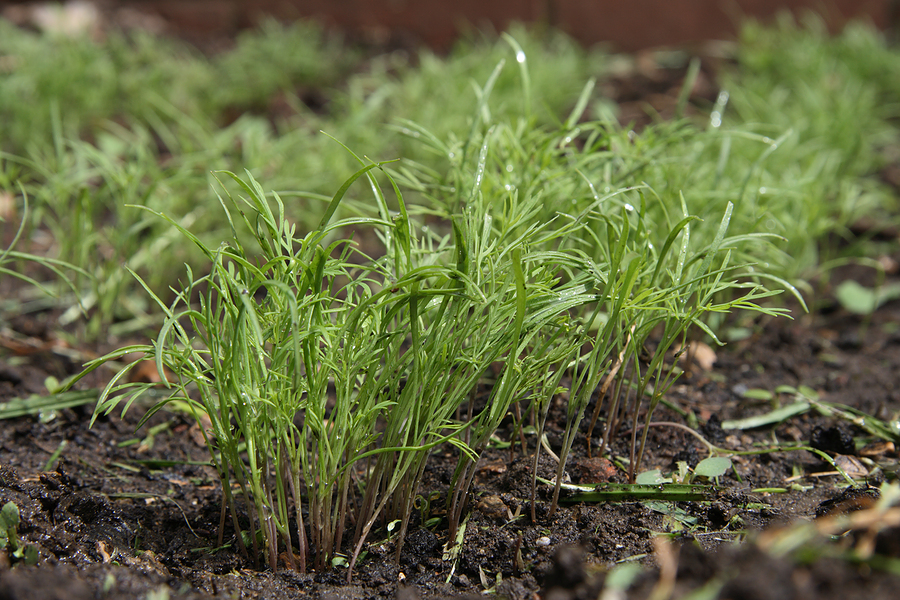Herbs well suited for growing in cool weather are cilantro, chervil, chives, dill, and parsley. Unlike warm-weather summer-grown herbs, cool-weather herbs can be sown directly in the garden a month or more before the last frost in spring for late spring harvest and again in late summer for fall harvest.
Cool-season herbs grow best in soil rich in aged compost. Compost-rich soil retains moisture, is well-drained, and contains the important nutrients necessary for cool-season herbs to thrive. (Many warm-weather herbs such as rosemary are native to the Mediterranean and will grow well in less-fertile conditions.)
Cool-season herbs prefer cool temperatures to grow to maturity but germinate most quickly in warm soil. To speed the germination of cool-season herbs soak them overnight in water before sowing then cover the seedbed with clear plastic to help warm the soil.
Sow cool-season herbs in the garden up to a month before the last expected frost in spring, to harvest them at the peak of flavor. When temperatures rise in late spring or early summer cool-weather herbs will bolt—that is their stalks will elongate, develop flowers, bloom, and go to seed. Bolting turns herbs bitter.

Cool-weather herb growing tips
• Cilantro is a cold-hardy annual herb. Cilantro seeds can be sown a week or two before the last frost in spring and again in late summer. It can also be grown from fall to spring when winter temperatures are mild. For best germination, soak seeds in water overnight before sowing. Cilantro leaves have a parsley-sage-citrus flavor. Cilantro seeds are known as coriander and have a citrus and spice flavor. More on growing cilantro at How to Grow Cilantro and Cilantro and Coriander: Kitchen Basics.
• Chervil is a half-hardy annual. It can be sown three to four weeks before the last frost in spring and again in late summer. Chervil grows best in light shade but seeds require light to germinate. Soak seeds for up to 24 hours before sowing to speed germination. Thin seedlings to 6 to 9 inches apart. Chervil resembles parsley and has a delicate anise-like flavor. How to Grow Chervil.
• Chives are a cold-hardy perennial herb. Chives can be grown from seeds, transplants, or divisions. Sow seeds or set out six-week-old transplants about four weeks before the last frost in spring. Divide clumps every two to four years in spring or fall. Chives have a delicate onions flavor. Garlic chives have a mild garlic flavor. More on growing chives at How to Grow Chives and Chives: Kitchen Basics.
• Dill is a cold-hardy annual herb. Sow dill in the garden four to five weeks before the last frost in spring. Seeds require light to germinate. Dill can also be sown in fall in mild winter temperatures regions. More on growing dill at How to Grow Dill and Dill: Kitchen Basics.
• Parsley is a hardy biennial herb commonly grown as an annual. Direct sow seeds or set out six- to eight-week-old transplants about a week before the last frost in spring. Where winters are mild parsley can be sown in late winter. Parsley seeds are slow to germinate; soak them or freeze them overnight before sowing. Parsley can be grown in full sun or partial shade. Italian parsley with its celery and cilantro-like leaves is more flavorful than curly parsley. Harvest the outer leaves or cut the whole plant down to a couple of inches above the soil and it will regrow. How to Grow Parsley and Parsley: Kitchen Basics.
Related Articles on Herb Growing:
Related articles:
Best Herbs for Container Growing
Growing Herbs Indoors in Winter
Planning the Home Fruit Garden
Garden Planning Books at Amazon:
- Vegetable Garden Almanac & Planner
- Kitchen Garden Grower’s Guide Vegetable Encyclopedia
- Vegetable Garden Grower’s Guide
- Tomato Grower’s Answer Book



